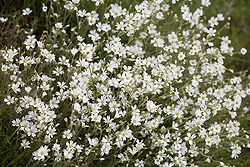Difference between revisions of "Cerastium arvense"
(→Distribution) |
(→Habitat) |
||
| Line 27: | Line 27: | ||
==Habitat== | ==Habitat== | ||
| + | Coastal cliffs to inland valleys, rocky hillsides, subalpine meadows. | ||
| + | |||
| + | Light (sandy), medium (loamy) and heavy (clay) soils and requires well-drained soil | ||
| + | medium | ||
| + | |||
| + | Acid, neutral and basic (alkaline) soils. | ||
| + | |||
| + | Dry or moist soil – drought intolerant | ||
| + | |||
| + | Sun – shade intolerant | ||
| + | |||
==Uses== | ==Uses== | ||
==Propagation== | ==Propagation== | ||
Revision as of 07:47, 14 May 2012
Common name: Field chickweed
Abbreviation code: CEAR
Contents
Taxonomy
- Kingdom: Plantae
- (unranked): Angiosperms
- (unranked): Eudicots
- (unranked): Core eudicots
- Order: Caryophyllales
- Family: Caryophyllaceae
- Genus: Cerastium
- Species: C. arvense
Description
General: Tufted perennial, often forming loose mats to 4 dm. broad, glabrous to glandular-pubescent, the flowering stems 5-50 cm. tall.
Leaves: Leaves opposite, linear to narrowly lanceolate, 1-nerved, 1-3 cm. long; cauline leaves often with bundles of secondary leaves in their axils.
Flowers: Flowers 3 to 5 or more in an open inflorescence; pedicels slender, erect, 1-3 cm. long; sepals 5, 4-6 mm. long, with stalked glands; petals 5, white, twice as long as the sepals, deeply bi-lobed-obcordate; stamens 10; styles 5. Fruit: Capsule membranous, cylindric, slightly curved, 1.5 times as long as the sepals, opening by 10 teeth.
Bloom Period
April - Aug
Distribution
Both sides of the Cascades and in the Blue Mountains in Washington. Widely distributed throughout North America.
Habitat
Coastal cliffs to inland valleys, rocky hillsides, subalpine meadows.
Light (sandy), medium (loamy) and heavy (clay) soils and requires well-drained soil medium
Acid, neutral and basic (alkaline) soils.
Dry or moist soil – drought intolerant
Sun – shade intolerant
Uses
Propagation
Seed
Seed sample from: 2011
Average Measurement: 0.9 x 0.9 x 0.5
Measurement Range: L: 0.75 – 1, W: 0.8 – 1, D: 0.4 – 0.6
Shape: Seed somewhat kidney shaped, narrower at hilum and broadening at opposite apex. Hilum pinched.
Color: Rusty brown to orange brown. Hilum white.
Surface: Matte and covered with many small bumps, arranged in concentric half circles originating at the hilum and broadening at the opposite apex.
Latitudinal Cross Section: elliptical ![]()
Longitudinal Cross Section: obovate ![]()
Basic Explanations and Assumptions:
The dimensions for the seeds are length x width x depth. The location of the hilum is used as the base of the seed, and the length is measured from hilum to the opposite apex. Where a style is present, the length is measured from the hilum to the bottom of the style. Width is measured at a right angle to the length at the widest part. Depth is measured at a right angle to the intersection of height and width lines.
Measurements included are the mean average for each measurement of ten separate seeds.
All measurements in millimeters unless otherwise noted.


